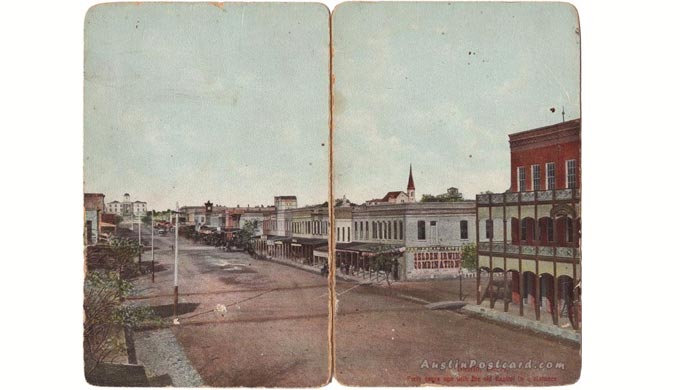A madman wielding an ax threw Austin, Texas, into a turmoil of fear and paranoia. The midnight killing sprees took place from December 30th, 1884, to Christmas Eve, 1885. Only a few years removed from the threat of Comanche raids, Austinites were confronted with a strange new kind of murderer. A serial killer whose sole motives were rage and bloodlust. Who was the Servant Girl Annihilator? Some investigators believe that before he stalked the foggy streets of London, Jack the Ripper struck first in the Texas Hill Country.
 austinpostcard.com
austinpostcard.com
History
Was Austin’s Ax Man Jack the Ripper?

Photo: strangeco.blogspot.com
The great short story writer William Sydney Porter, better known as O. Henry, called Austin home in 1885. In a letter to a friend, Porter referred to the killer as the Servant Girl Annihilator, so called because most of the victims worked as domestic servants. 130 years later, with the murders still officially unsolved, Porter’s nickname is how the killer is remembered.
Seven of the eight murder victims were women, five black, two white. The first body was that of a 25-year-old, mixed-race woman named Mollie Smith. She was found behind 901 West Pecan Street—which is now 6th Street. They were assaulted in their own homes in the dead of night, brutally axed while asleep in bed. The killer then dragged them outside into the backyard where he raped and killed them, often leaving a bloody ax behind. Most of the women led hard-working lives, with little to show for their labor except families who loved them. After the actions of the demented killer, those families were left grieving their loss for decades.
Police found bloody footprints at the scene of the crimes. The killer went barefoot to creep silently into homes. The prints were distinctive: his right foot was missing a toe. Packs of bloodhounds went baying down dirt streets in the moonlight, chasing the ax man’s scent. Possible eyewitnesses gave conflicting reports: a white man, a black, a man wearing a Mother Hubbard dress.

Photo: austinpostcard.com
Many citizens believed it was the work of more than a single killer. A curfew was declared. The police force tripled in size and a vigilance committee of armed citizens patrolled the city. As a result of the murders, the Austin Moon Towers were constructed a decade later to illuminate the dark streets. Some believed the killer chloroformed his victims before chopping them. In the 19th century, chloroform was often used in robberies to disable victims. Historical documents reveal fascinating details about the extent of the precautions Austinites took to protect themselves. In case the ax man attempted to inject chloroform through the keyhole, two Austin women poured water into tubs set inside their front and back doors to absorb the compound.
The final murders occurred on Christmas Eve, 1885. Sue Hancock’s husband discovered his wife’s body in their backyard—the present-day site of the Four Seasons Hotel. A short time later, Eula Phillips was found murdered near the present-day location of the Austin Public Library. Phillips was a beautiful woman with a troubled life. She was likely a prostitute and rumors exist that several Austin politicians were among her clients.

Murder victim Eula Phillips. Photo: strangeco.blogspot.com
Then the murders stopped as suddenly as they began. Three years later, Jack the Ripper shocked the world with his slashing of prostitutes in the White Chapel district of London’s East End. In November 1888, according to the Atchison Daily Globe, the Austin American-Statesman reported on a possible American connection to the Ripper: a Malay cook on an ocean vessel was suspected in the White Chapel killings. The article went on to report that a Malay cook had been working at a small Austin hotel called the Pearl House “near the foot of Congress Avenue.” The Austin reporter learned a Malay cook named Maurice had worked there in 1885 before departing in January 1886. The last killings occurred just before Maurice left Austin. “A strong presumption that the Malay was the murderer of the Austin women was created by the fact that all of them except two or three resided in the immediate neighborhood of the Pearl House.”
A 2014 episode of History Detectives identified another suspect. In 1885, Nathan Elgin was a 19-year-old black man living in Austin and working as a cook in a downtown restaurant in close proximity to the crime scenes. One night in February 1886, a drunken, raging Elgin dragged a screaming girl out of an Austin saloon and into a nearby house. The police soon arrived and a cop named Bracken shot Elgin. The bullet lodged in his spine. Elgin was paralyzed and died the following day. An autopsy revealed something startling: Elgin was missing his right toe. Sheriff Malcom Hornsby believed Elgin was the Servant Girl Annihilator due to the distinctive footprints and the fact no murders were committed after his death.
Yet the mystery remains: who was the Servant Girl Annihilator? Were the murders the work of one man, or a pair of killers? Did Jack the Ripper once visit the Lone Star state?

